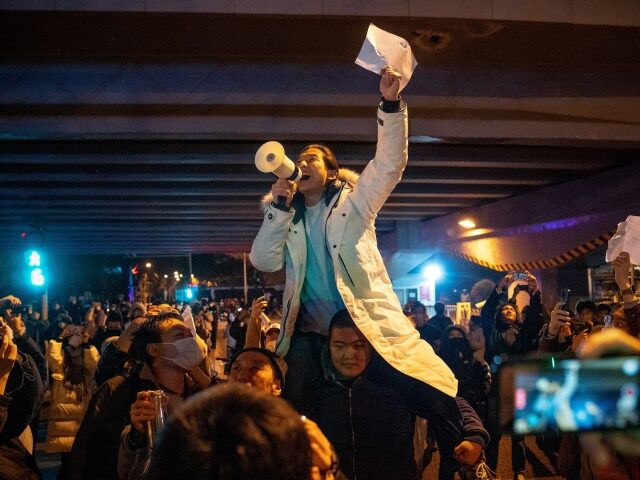Despite a brutal crackdown by the Chinese Communist regime, anti-lockdown protests continued in cities across China on Tuesday, including a band of courageous “blank paper” protesters who assembled on a pedestrian bridge in Beijing, inspired by the courageous dissident who hung banners critical of dictator Xi Jinping from a bridge in October.
At #SitongBridge in #Beijing today. The #BlankPapersRevolution is still going on and drivers also honk to support.
Why SitongBridge? Watch my show to find out https://t.co/dslW1BCq1l#China #ChinaUprising #ChinaRevolution #chinacovidprotest #ChinaProtests2022 pic.twitter.com/xCTYzBYpTW— Jennifer Zeng 曾錚 (@jenniferzeng97) November 30, 2022
Local residents noted the bridge in the above video is not the same as the one from the famous protest in October, but the scene was apparently meant to be evocative of the October demonstration. Also, standing on a bridge over road with heavy traffic is a good way to get noticed.
The blank pieces of paper held by the people lining the bridge are a symbol of defiance that became popular during the Hong Kong pro-democracy uprising of 2019.
One of the protest marches held in Beijing on Monday was supposed to lead to Sitong Bridge, but the police took steps to keep the symbolic location from featuring too prominently:
The police also turned off the lights at Sitong Bridge in Haidian, the end point of the planned protest march on Monday. This bridge was where a lone protester unfurled two banners criticising Xi Jinping and China's zero-Covid policy in October before the 20th party congress. pic.twitter.com/LcnVZ3DM5d
— Dawn Wei Tan (@dawn_wei_tan) November 28, 2022
Both Xi Jinping and his detractors were surprised by the audacity of the lone individual who hung protest banners from Beijing’s Sitong Bridge in October, just days before the National Party Congress that secured an unprecedented third term in power for Xi.
“We want food, not PCR tests. We want freedom, not lockdowns. We want respect, not lies. We want reform, not a Cultural Revolution. We want a vote, not a leader. We want to be citizens, not slaves,” one of the banners read, presaging the anti-lockdown protests that would sweep China near the end of the following months.
“Go on strike, remove dictator and national traitor Xi Jinping,” read another. The words from those banners were frequently chanted by demonstrators over the past weekend.
It wasn't too long ago that people on China Twitter were hotly debating whether the solo protest at #SitongBridge by aerospace researcher #PengLifa would have any impact at all.
Now, people across #China can be heard chanting his pro-democracy slogans and denouncing Xi Jinping. https://t.co/fHDze1MT1c
— William Nee (@williamnee) November 29, 2022
After Peng Lifa's Sitong Bridge protest in October, his slogan "Freedom, not Lockdown" had circulated within China but only in secrecy. This weekend, thousands chanted those words loudly in Shanghai, Beijing and other cities. Truly sparkling. https://t.co/dGSIFPJL7z
— FAN Wenxin (@xinwenfan) November 27, 2022
The man who hung the banners became known to dissidents and human rights activists as “Bridge Man,” an admiring nod to the amazing “Tank Man” of Tiananmen Square in 1989 – an ordinary-looking fellow holding some shopping bags who stopped in the middle of the street to stare down a line of tanks. Some admirers prefer to honor the Sitong Bridge protester as the “Lonely Warrior,” a character from a Chinese pop song.
China’s vast censorship apparatus went into overdrive, frantically deleting images of the banners and even briefly banning the use of words like “bridge” to suppress news of Bridge Man’s defiant actions, but, in another foreshadowing of today’s anti-lockdown protests, the news spread too quickly and too many images of the banners were saved to foreign websites where Xi’s goons could not reach them.
“The person has disappeared, the name of the site has disappeared, so many words are disappearing. But there are so many Chinese characters, so many pair of eyes. Can you censor us all?” one social media commentator said in October.
Chinese police arrested Bridge Man shortly after his demonstration, identifying him as a construction worker named Peng Lifa. There has been little news of his fate since then, but many fear he has been killed or tortured.
Chinese dissidents spoke of Bridge Man in hushed tones, scarcely able to believe his courage. More banners and protest signs were displayed in sympathy demonstrations around the world, as has been the case with the anti-lockdown demonstrations. With six weeks of hindsight, it seems clear that regime officials did not take Bridge Man seriously enough.

COMMENTS
Please let us know if you're having issues with commenting.